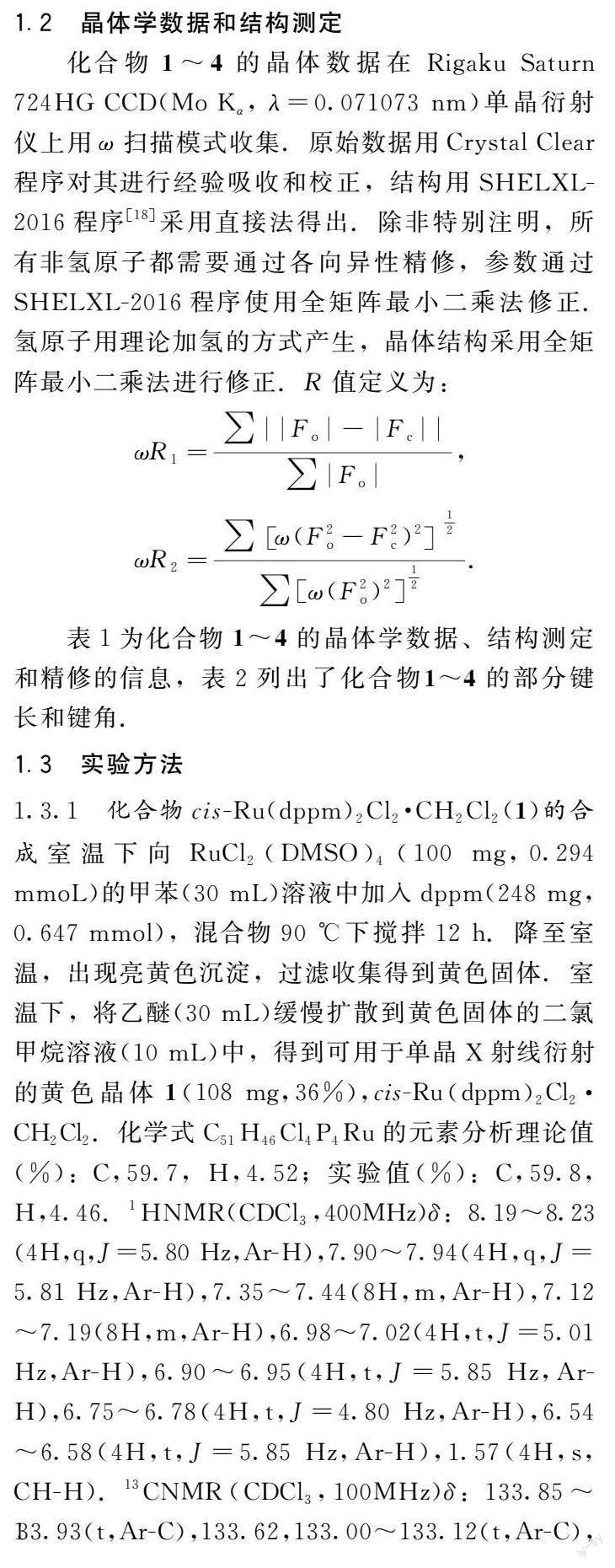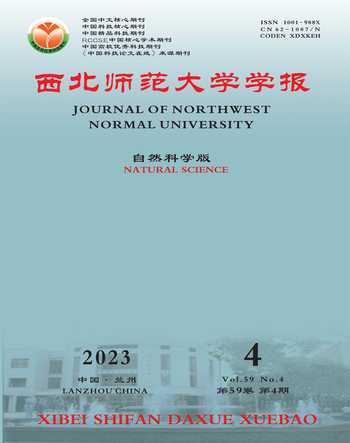顺式/反式双齿膦单核钌化合物的合成、晶体结构和光谱研究
彭佩 王勇



基于過渡金属原子的电子结构及与之配位的配体多样性,目前已经合成了种类和数量众多的过渡金属配合物[1-2].这些配合物表现出丰富的光物理、光化学和电化学性质,使其在发光、电子转移、生物传感器、催化剂和染料敏化太阳能电池等领域有广泛的应用[3-4].因此,引起了人们对具有八面体构型的 4d6和 5d6金属配合物的兴趣,这些金属配合物的合成与光物理以及化学性质已成为各个领域研究的热点[5-6].4d6钌金属配合物具有独特的物理、化学性质,分子本身具有较强的可塑性,可以通过改变配体或对其修饰,从而改变配合物的性质[7-8].目前许多钌金属配合物被不断设计合成出,并广泛应用于多个研究领域.其中,发光的钌配合物尤其引人注目,这主要是由于其本身具有优异的光物理、光化学性质以及十分稳定的电化学氧化还原性.膦配体是过渡金属最常使用的配体类型之一,它们与金属有很强的结合能力,空间结构易于调节,制备方法简单,研究人员可根据膦配体的空间和电子性质,精确地设计出所需的过渡金属配合物.近年来,因为在催化、光谱学、电化学等研究中具有广阔的应用前景,含双齿膦配体的过渡金属配合物引起了广大科研工作者的兴趣[9-11].
过渡金属配合物的化学和物理性质取决于配体在金属中心周围的几何排列,除了它们不同的物理特性外,几何异构体的化学性能也可能不同[12-13].尽管八面体金属配合物中的顺/反异构现象很常见,但同时系统研究顺/反异构体的例子还不是很多.如果金属配合物的顺反异构化能导致材料性能发生显著变化,将为未来的材料发展开辟许多可能性.
基于对顺式/反式构型含双膦配体钌化合物的兴趣[14-15],文中合成了4个螯合双膦单核钌化合物cis-Ru(dppm)2Cl2 (1),trans-Ru(dppm)2Cl2 (2),cis-Ru(dppe)2Cl2(4)和trans-Ru(dppm)2Cl2 (4),并对这4个化合物进行了核磁共振氢谱、碳谱、磷谱和X 射线单晶结构分析.此外,还研究了化合物 1~4 的紫外-可见吸收光谱和荧光光谱.
31PNMR和单晶X射线衍射分析等手段对化合物1~4进行了结构表征.结合晶体结构数据和紫外-吸收光谱,表明顺式异构体具有比反式异构体更低的能量,是一种更稳定的结构.
参考文献:
[1] YANG Y Y,ZHU X Q,WANG Y,et al.Effect of potential difference between the central and terminal metals on the electron communication in an Fe-Ru-Fe cyanidometal-bridged mixed valence system[J].Inorg Chem Front,2022,9(18):4732.
[2] SEN S,WON M,LEVINE M S,et al.Metal-based anticancer agents as immunogenic cell death inducers:the past,present,and future[J].Chem Soc Rev,2022,51(4):1212.
[3] GOURDON L,CARIOU K,GASSER G.Phototherapeutic anticancer strategies with first-row transition metal complexes:a critical review[J].Chem Soc Rev,2022,51(3):1167.
[4] VOLARIC J,SZYMANSKI W,SIMETH N A,et al.Molecular photoswitches in aqueous environments[J].Chem Soc Rev,2021,50(22):12377.
[5] PETE S,ROY N,KAR B,et al.Construction of homo and heteronuclear Ru(Ⅱ), Ir(Ⅲ) and Re(Ⅰ) complexes for target specific cancer therapy[J].Coord Chem Rev,2022,460:214462
[6] YEUNG C F,SHEK H L,YIU S M,et al.Controlled activation of dipicolinyl-substituted propargylic alcohol by Ru(Ⅱ)and Os(Ⅱ)for unprecedented indolizine-fused metallafuran complexes[J].Organometallics,2021,40(15):2458.
[7] RUPP M T,SHEYCHENKO N,HANAN G S,et al.Enhancing the photophysical properties of Ru(Ⅱ) complexes by specific design of tridentate ligands[J].Coord Chem Rev,2021,446:214127.
[8] UDYARDY A,JOO F,KATHO A.Synthesis and catalytic applications of Ru(Ⅱ)-phosphaurotropine complexes with the use of simple water-soluble Ru(Ⅱ)-precursors[J].Coord Chem Rev,2021,438:213871.
[9] TAKEDA H,KOBAYASHI A,TSUGE K.Recent developments of photoactive Cu(Ⅰ)and Ag(Ⅰ) complexes with diphosphine and related ligands[J].Coord Chem Rev,2022,470:214700.
[10] WANG X M,HAN Z B,WANG Z,et al.A type of structurally adaptable aromatic spiroketal based chiral diphosphine ligands in asymmetric catalysis[J].Acc Chem Res,2021,54(3):668.
[11] WIEDNER E S,APPEL A M,RAUGEI S,et al.Molecular catalysts with diphosphine ligands containing pendant amine[J].Chem Rev,2022,122(12):12427.
[12] KAYA Z,BENTOUHAMI E,PELZER K,et al.Cavity-shaped ligands for asymmetric metal catalysis[J].Coord Chem Rev,2021,445:214066.
[13] ASSEN A H,ADIL K,CORDOVA K E,et al.The chemistry of metal-organic frameworks with face-centered cubic topology[J].Coord Chem Rev,2022,468:214644.
[14] WANG Y.Synthesis,structural and metal-to-metal charge transfer properties of cyanide-bridged compound FeⅡ/Ⅲ-NC-RuⅡ-CN-FeⅡ/Ⅲ[J].New J Chem,2022,46(8):3978.
[15] LIU M,HU J,WANG Y.Synthesis,crystal structure and MMCT of a heterobimetallic cyanide-bridged complex trans-BrRuⅡ(dppe)2(μ-CN)(FeⅢBr3)[J].Polyhedron,2018,149:79.
[16] SULLIVAN B P,CALVERT J M,MEYER T J.Cis-trans isomerism in (trpy)(PPh3)RuC12:comparisons between the chemical and physical properties of a Cis-trans isomeric pair[J].Inorg Chem,1980,19(5):1404.
[17] EVANS I P,SPENCE A,WILKINSON G.Dichlorotetrakis(dimethyl sulphoxide) ruthenium(Ⅱ) and its use as a source material for some new ruthenium(Ⅱ) complexes[J].J Chem Soc,Dalton Trans,1973(2):204.
[18] SHELDRICK G M.Program for X-ray Crystal Structure Refinement[M].Gttingen:University of Gttingen,Germany 2016.
(責任编辑 陆泉芳)

